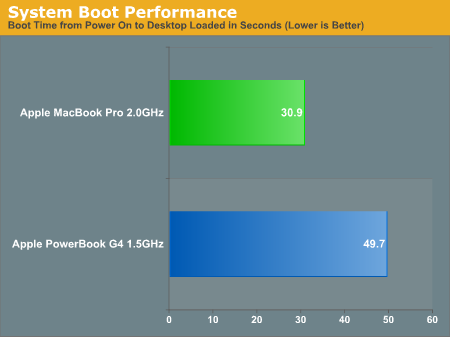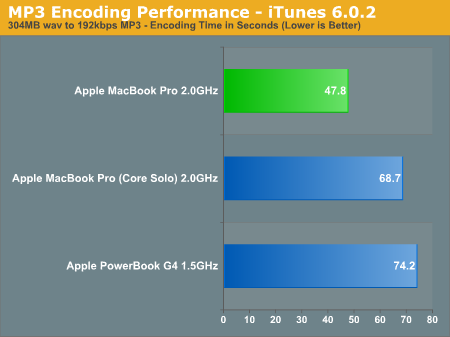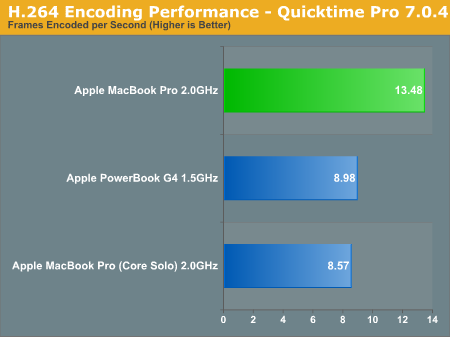Apple's MacBook Pro: Using it as a Mac and a PC
by Anand Lal Shimpi on April 13, 2006 12:00 AM EST- Posted in
- Mac
Performance Comparison: G4 vs. Core Duo
Before I get to the actual numbers comparing my PowerBook G4 1.5GHz to the MacBook Pro 2.0GHz, I should say that actually using the machine felt a lot faster. Just scrolling through a Finder window is so much faster on the MacBook Pro than on the old G4. Everything is a lot more responsive and the system as a whole feels desktop-fast. That being said, I can't get away without putting it to the test so here we have it - a PowerMac G4 1.5GHz vs. a MacBook Pro 2.0GHz.
Both systems are configured the way they were from Apple, with 1GB of memory but the original hard drives in each. Obviously the MacBook Pro has an advantage there because of its newer hard drive, however most of my tests aren't very disk bound minimizing the impact of differing hard drives. First off, we've got the good ol' boot test:

The MacBook Pro boots much quicker than the old PowerBook G4, much like the iMac Core Duo boots faster than the iMac G5. While the PowerBook G4 boots (from power on to desktop fully loaded) in just under 50 seconds, the MacBook Pro does it in just over 30 seconds. Although personally I keep my notebook on almost as much as my desktop, boot time is important for traveling where I'm constantly turning my machine on and off.
Just like in my iMac Core Duo review, wherever benchmarks/applications were multi-threaded I tried turning off the second core on the MacBook Pro to give you a good idea of what a Core Solo would be performing like up against the PowerBook G4. Not only is this interesting to look at, but there's also a good possibility that the future iBook replacement will have Core Solo as a processor option. The first two tests here both happen to be multi-threaded so you'll see results from both the Core Solo and Core Duo setups.

The MacBook Pro is ridiculously fast compared to the PowerBook G4 in converting MP3s using iTunes: the encode time is around 35% lower on the MacBook Pro. Disabling one of the cores does significantly level the playing field, although the Core Solo at 2.0GHz still manages to be a bit faster than the G4 1.5.

Under QuickTime we see a full 50% increase in performance over the PowerBook G4. If you disable the second core, the G4 1.5 actually pulls ahead of the Core Solo 2.0. The PowerBook to MacBook Pro upgrade, purely from a performance stance, is looking very impressive already.










52 Comments
View All Comments
Calin - Thursday, April 13, 2006 - link
This could be thanks to slower drivers in BootCamp Windows XP, or slower hard drive access/speed. Everything else is a disadvantage for VM: one more level of indirection in disk access, less memory, running the OS X behind the VM.Could you do some disk speed comparation between VM and native XP?
BigLan - Thursday, April 13, 2006 - link
I think it's going to be hard drive speed throwing off the benchmarks. The BootCamp partition is going to be at the outer edge of the disk, with much slower speeds than the VM client virtual drive which is on the faster Apple partition.I'm not sure if it's possible to assign the entire HD to a windows partition using Bootcamp, but that's about the only way i can think of to level the playing field.
Calin - Friday, April 14, 2006 - link
To nitpick, it would be at the center of the hard drive, not at the outer edge :) (ok, based on sector numbers, which starts at the edge).Near the "end" of the hard drive, the transfer speed is reduced (there are fewer bytes on a full circle).
jimmy43 - Thursday, April 13, 2006 - link
Excellent Review. This may be my first laptop purchase, seems to have everything I could possibly want.monsoon - Thursday, April 13, 2006 - link
Hello Anand,...i'm waiting for Parallels to finalize their VT release and maybe Merom Macs too...
I was wondering if the ONE CORE only VT tech is to be the final result of their virtualization software or just a middle-step.
Seems to me it's rather poor a solution ( ok, it's the best out there for now ) to use a dual-core computer to run both OS on a single core
=/
Better would be smart distribution of tasks to the CPU depending on which OS is actually under load...
...any thoughts / info on that ?
Thanks for your nice review !=)
plinden - Thursday, April 13, 2006 - link
Looking at CPU load while running Parallels VM, I see the load spread evenly over both processors (usually < 10% total CPU except at boot, when it reaches 150% CPU). It's just that the VM itself sees itself as running on a single processor.
shuttleboi - Thursday, April 13, 2006 - link
I've read that the ATI X1600 in the Mac can run games well, but only IF you overclock the GPU. I can't imagine the Mac getting any hotter than it already supposedly is, and the idea of overclocking an already hot laptop is not appealing.JoKeRr - Thursday, April 13, 2006 - link
Overall I enjoyed it.Would have been nice to see a comparison of screen brightness, as apple claimed 67% brighter!
And also, the slowness in windows, could it be related to chipset driver stuff?? And what's the gaming experience so far like?? Would it be similar to a desktop 6600 or 6600gt??
Thank you.
rolls - Friday, April 14, 2006 - link
Very interesting numbers all round.35% improvement in iTunes when comparing a single core 1.5GHz 7447 with the old slow bus etc, and a new 33% faster dual core intel CPU. 50% improvement in H.264 encoding etc. These numbers suggest that had Apple stuck with Freescale and moved to e600 core based systems, performance figures could have been off the scale. If only...
JarredWalton - Thursday, April 13, 2006 - link
On paper the X1600 Pro desktop cards actually look pretty decent. 12 pipelines at 500 MHz, with 800 MHz RAM. I would have thought they would at least give the 6600GT a run for the money, given how X1800 compares to 7800. Amazingly (to me), the X1600 gets completely stomped by the 6600GT. What's worse, the cards I have can't even overclock worth a darn on the memory side - 800 is stock, and they get unstable at even minor changes. (Could be an issue with the overclocking tool, though?)Anyway, for now I would say X1600 Mobility is going to be somewhere in the realm of 6600 (non-GT) performance, maybe slightly faster. That means gaming is definitely possible, but you will want low-to-medium detail levels for any recent titles. Just a guess, of course, and Anand will have to run benches to get any final confirmation. Really, though, this laptop isn't intended as anything more than a light gaming solution.